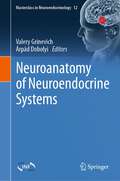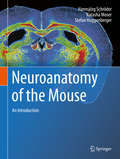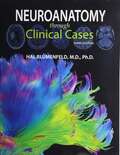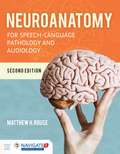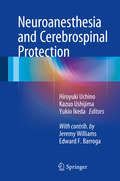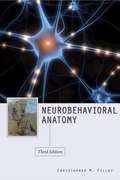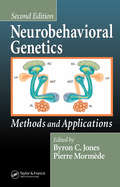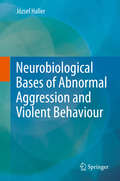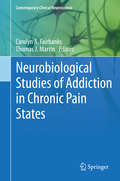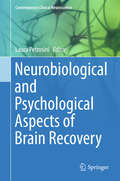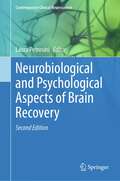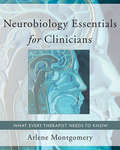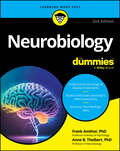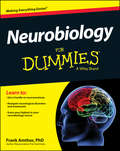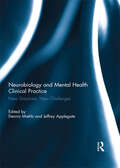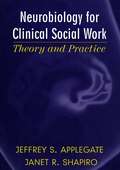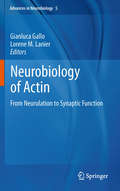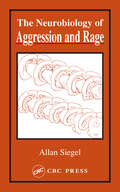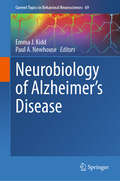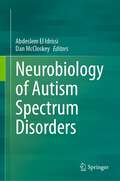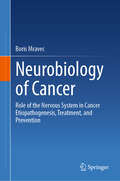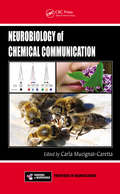- Table View
- List View
Neuroanatomy of Neuroendocrine Systems (Masterclass in Neuroendocrinology #12)
by Valery Grinevich Árpád DobolyiIn this book, experts in the field provide comprehensive descriptions of the neuroanatomy of the hypothalamic neuroendocrine systems.The book begins with an extensive discussion on the structural components of the neuroendocrine systems. The reader will be introduced to the anatomy and biology of the hypothalamus and the pituitary. The human hypothalamus is presented in particular detail using state-of-the-art imaging techniques. In the next section, the neuroanatomy of traditional hypothalamo-hypophyseal systems is highlighted, with chapters describing magnocellular neuroendocrine cells and discussing the respective types of hypothalamic neurons that regulate various pituitary hormones. Following this detailed structural and anatomical description of the neuroendocrine system, the book’s final section focuses on the hypothalamic control of neuroendocrine functions. This includes the control of circadian rhythm, metabolism and appetite via specific peptidergic circuits.This book provides essential information on the neuroanatomy and control of neuroendocrine systems, addresses cutting-edge research questions posed by recent advances in the development of potent neuroanatomical tools, and highlights the latest technologies used in neuroendocrinology research, making it a valuable reference guide for students, trainees and established researchers alike. This is the twelfth volume in the International Neuroendocrine Federation (INF) Masterclass in Neuroendocrinology series, which aims to illustrate the highest standards and to encourage the use of the latest technologies in basic and clinical research and hopes to provide inspiration for further exploration into the exciting field of neuroendocrinology.
Neuroanatomy of the Mouse: An Introduction
by Stefan Huggenberger Natasha Moser Hannsjörg SchröderThis textbook describes the basic neuroanatomy of the laboratory mouse. The reader will be guided through the anatomy of the mouse nervous system with the help of abundant microphotographs and schemata. Learning objectives and summaries of key facts at the beginning of each chapter provide the reader with an overview on the most important information.As transgenic mice are one of the most widely used paradigms when it comes to modeling human diseases, a basic understanding of the neuroanatomy of the mouse is of considerable value for all students and researchers in the neurosciences and pharmacy, but also in human and veterinary medicine. Accordingly, the authors have included, whenever possible, comparisons of the murine and the human nervous system. The book is intended as a guide for all those who are about to embark on the structural, histochemical and functional phenotyping of the mouse’s central nervous system. It can serve as a practical handbook for students and early researchers, and as a reference book for neuroscience lectures and laboratories.
Neuroanatomy through Clinical Cases
by Hal BlumenfeldNeuroanatomy through Clinical Cases is widely acclaimed for bringing a pioneering interactive approach to the teaching of neuroanatomy. The book uses over 100 actual clinical cases and high-quality radiologic images to bring the subject to life. The third edition is fully updated with the latest advances in the field, and includes several exciting new cases. This approach allows students to appreciate the clinical relevance of structural details as they are being learned, and to integrate knowledge of disparate functional systems, so the practical knowledge of neuroanatomy is not soon forgotten.
Neuroanatomy: For Speech-Language Pathology and Audiology
by Matthew RouseThis student-friendly and engaging text is organized into four main sections: Part I introduces students to the nervous system; Part II discusses the main neurological structures; Part III focuses on the neurology of speech, language, hearing, cognition, emotion, and swallowing; and Part IV delves into practicing neuroanatomy in the field.
Neuroanesthesia and Cerebrospinal Protection
by Hiroyuki Uchino Kazuo Ushijima Yukio IkedaThis book is a knowledge-based text that covers the anatomy, neurophysiology, and neuropharmacology needed to carry out the necessary management and cerebrospinal protection during neuroanesthesia. Especially to make the subject of neuroanesthesia more approachable, we introduce surgical measures utilized in neurosurgery, cardiovascular surgery, neuromodulation, and related procedures. The main purpose of neuroanesthesia/neurocritical care is to deliver cerebrospinal protection in neurosurgical and cardiovascular surgeries. How should we select the best anesthetic management to prevent neurological complications for patients who, for instance, undergo different types of surgery for subarachnoid hemorrhage, stroke, head trauma, carotid endarterectomy, or cardiovascular surgery under cardiopulmonary bypass? These pathological conditions include the risk of transient cerebrospinal ischemia, and if our management is not precise, it may induce serious neurological sequelae. Although there is an urgent need to establish the treatment and elucidate the molecular mechanisms of cerebrospinal injury, many components are intertwined, making this a challenge we have not completely solved yet. This volume makes the management of neuroanesthesia more accessible not only for primary residents but also for specialists, providing a valuable resource on the current perspectives of neuroanesthesia.
Neurobehavioral Anatomy, Third Edition
by Christopher M. FilleyThoroughly revised and updated to reflect key advances in behavioral neurology, Neurobehavioral Anatomy, Third Edition is a clinically based account of the neuroanatomy of human behavior centered on a consideration of behavioral dysfunction caused by disorders of the brain. A concise introduction to brain-behavior relationships that enhances patient care and assists medical students, the book also serves as a handy reference to researchers, neuroscientists, psychiatrists, and geriatricians. The book outlines how cognitive and emotional functions are represented and organized in the brain to produce the behaviors regarded as uniquely human. It reviews the effects of focal and diffuse brain lesions, and from this analysis a conception of the normal operations of the healthy brain emerges. Christopher M. Filley integrates data and material from different disciplines to create a concise and accessible synthesis that informs the clinical understanding of brain-behavior relationships. Clinically practical and theoretically stimulating, the book is an invaluable resource for those involved in the clinical care and study of people with neurobehavioral disorders. Including a useful glossary and extensive references guiding users to further research, the third edition will be of significance to medical students, residents, fellows, practicing physicians, and the general reader interested in neurology.
Neurobehavioral Genetics: Methods and Applications, Second Edition
by Byron C. Jones D. V. M. Pierre MormèdeA complete background to concepts and principles of behavioral genetics, Neurobehavioral Genetics: Methods and Applications, Second Edition features a broad spectrum of the most current techniques in neurobehavioral genetics in a single source. International researchers incorporate several new developments in the field, including:De
Neurobiological Bases of Abnormal Aggression and Violent Behaviour
by József HallerMechanisms controlling aggressive behavior started to be identified from late 20's of the 20th century and subsequent research described such mechanisms in great detail. While the findings are of great relevance for the understanding of aggression per se, they provide limited insights into the mechanisms of abnormal aggression i. e. those mechanisms that underlie aggression-related psychopathologies. While basic phenomena and mechanism of aggression are presented, this book is the first that comprehensively describes ultimate and proximate mechanisms that transform normal (laboratory animals) or tolerable (humans) manifestations of aggressiveness into abnormal patterns in laboratory animals and aggression-related psychopathologies in humans. This book is written for behavioral neurobiologists and neuroscientists, interested in emotional control in general and aggression research in particular. The book will also offer important information to neurologists and psychiatrists dealing with aggressive behavior in the clinic and ultimately, may provide means to understand and on the long run to discover novel approaches to the treatment of abnormal human aggression.
Neurobiological Basis of Migraine
by Michael A. Moskowitz Turgay DalkaraPublished with the New York Academy of Sciences A timely, broad-ranging exploration of the neurobiological basis and molecular mechanisms of migraines Migraines impact the lives of a significant portion of the world's population, afflicting sufferers with severe pain, nausea, and often visual impairment. The WHO views migraines as an important public health issue, and ranks them in its top twenty most disabling illnesses. Neurobiological Basis of Migraine reviews the latest advances made in our understanding of the primary basic mechanisms of migraine headache and provides valuable insights into how these findings are being translated into novel treatment and prevention strategies around the world. Written for researchers and clinicians alike, the book features edited contributions from distinguished experts in the field, taking a focused, yet wide-ranging approach to the subject. It begins by exploring the pathways and networks mediating migraine headaches, their underlying physiological mechanisms, characteristics of visceral pain, and the concept of dural neurogenic inflammation. From there the authors delve into the mechanisms sustaining the head pain and photophobia associated with migraines, and they review the pharmacology of newly discovered migraine treatments. These basic chapters are followed by clinical and genetic studies linking to key issues, including cortical spreading depression, ion channels, transporters, and epilepsy. Reviews of the latest advances in our understanding of the neurobiological basis of migraine Translates important research findings from around the globe into novel treatments strategies currently being investigated Provides researchers and clinicians with a deep understanding of the primary mechanisms of migraine from migraine modeling to clinical applications Includes contributions by many of the most respected researchers in the field, world-wide Discusses exciting recent developments in migraine mutations and their role in CSD, as well as the role of CSD in aura and trigeminal activation Timely, comprehensive, and authoritative, Neurobiological Basis of Migraine is an indispensable working resource for clinicians and migraine, headache, and pain researchers, including neurobiologists, neuropharmacologists, neurologists, and vascular neurobiologists, as well as graduate students in those fields who are involved in researching migraine headaches.
Neurobiological Studies of Addiction in Chronic Pain States
by Carolyn A. Fairbanks Thomas J. MartinUsing rodent models, this volume explores the basic neurobiology of the relationship among chronic pain, opioid pharmacology, and addiction.
Neurobiological and Psychological Aspects of Brain Recovery
by Laura PetrosiniThe novelty of this book's approach lies in addressing the impact of neurobiological factors as well as psychological influences on brain recovery. There is growing evidence that emotional, motivational, and cognitive factors along with personality traits play a crucial role in brain plasticity, resilience, and recovery. Topics include synaptic and neuronal plasticity, development of brain reserves, biological markers, environmental factors, psychological profile, emotional resilience, and personality traits. By combining the latest research on neural mechanisms and on psychological resilience the authors hope that this book can lead to the development of better treatment strategies for functional recovery from brain damage.
Neurobiological and Psychological Aspects of Brain Recovery (Contemporary Clinical Neuroscience)
by Laura PetrosiniThe novelty of this book's approach lies in addressing the impact of neurobiological factors as well as psychological influences on brain recovery. There is growing evidence that emotional, motivational, and cognitive factors along with personality traits play a crucial role in brain plasticity, resilience, and recovery. Topics include synaptic and neuronal plasticity, development of brain reserves, biological markers, environmental factors, psychological profile, emotional resilience, and personality traits. By combining the latest research on neural mechanisms and on psychological resilience the authors hope that this book can lead to the development of better treatment strategies for functional recovery from brain damage.
Neurobiological and Psychological Aspects of Brain Recovery (Contemporary Clinical Neuroscience)
by Laura PetrosiniThe importance of this unique book's approach lies in addressing the impact of neurobiological factors as well as psychological influences on brain recovery following injury. There is growing evidence that emotional, motivational, and cognitive factors along with personality traits play a crucial role in brain plasticity, resilience, and recovery. Topics include synaptic and neuronal plasticity, development of brain reserves, biological markers, environmental factors, emotional resilience, and personality traits. By combining the latest research on neural mechanisms and psychological resilience the authors present a book that will help lead to the development of better treatment strategies for functional recovery from brain damage. The new edition is fully updated throughout and contains completely new chapters on brain recovery in childhood, epigenetic aspects of brain recovery, and artificial intelligence techniques in traumatic brain injury research.
Neurobiology Essentials for Clinicians: What Every Therapist Needs to Know
by Arlene Montgomery Allan N. SchoreThis book presents an overview of the latest theories of affect regulation and focuses on how these theories work in clinical settings and how therapists can be taught to implement them. The notion of teaching and learning will be extended by the theories themselves-the author presents methods of education that enact the theories being taught. The book is divided into eight chapters, each one highlighting a particular structure or related structures of the brain. Suggestions for learning how to clinically apply the neurobiological/neuroanatomical information are offered. What is so unique about this book is that the bulk of the chapters are clinical dialogue, accompanied by neurobiological commentary. Thus, readers can see for themselves, during the course of parts of sessions, just how a "neurobiological outlook" can inform therapeutic understandings of what clients are doing and saying. The result is a very user-friendly learning experience for readers, as they are taken along a journey of understanding various brain systems and how they relate to psychotherapeutic principles. Elegantly bridging the gap between the academic and clinical domains, this book is essential for anyone interested in the application of neurobiological principles to psychotherapy and wishes to learn about neurobiology without feeling overwhelmed or intimidated.
Neurobiology For Dummies
by Frank Amthor Anne B. TheibertAn essential guide to help you demystify the complex topic of neurobiology and jump into this fascinating scientific field Neurobiology is a notoriously difficult subject, but Neurobiology For Dummies explains the essentials in terms anyone can understand. This fun and accessible book covers the fundamentals, covering the anatomy, physiology, and pathology of the nervous system. Students in fields like neuroscience and pharmacology will get a complete overview of the molecular and cellular mechanisms of the nervous system, making it easier to complete coursework and pass exams in introductory neurobiology courses. In this updated edition, fresh examples highlight the latest research, so you'll be prepared with a current understanding of the science. Whatever your ultimate career destination, this Dummies guide will help you get neurobiology under your belt. Get easy-to-understand explanations of complex topics in neurobiology Understand the latest breakthroughs in neurological disease treatments Learn about the fascinating ways that the brain and body are interconnected Supplement your neurobiology textbook and prepare for your exam This is the perfect resource for students majoring in neuroscience, biology, cognitive science, medicine, and beyond. With Neurobiology For Dummies as a supplement, you can sail through any introductory neurobiology course.
Neurobiology For Dummies
by Frank AmthorThe approachable, comprehensive guide to neurobiology Neurobiology rolls the anatomy, physiology, and pathology of the nervous system into one complex area of study. Neurobiology For Dummies breaks down the specifics of the topic in a fun, easy-to-understand manner. The book is perfect for students in a variety of scientific fields ranging from neuroscience and biology to pharmacology, health science, and more. With a complete overview of the molecular and cellular mechanisms of the nervous system, this complete resource makes short work of the ins and outs of neurobiology so you can understand the details quickly. Dive into this fascinating guide to an even more fascinating subject, which takes a step-by-step approach that naturally builds an understanding of how the nervous system ties into the very essence of human beings, and what that means for those working and studying in the field of neuroscience. The book includes a complete introduction to the subject of neurobiology. Gives you an overview of the human nervous system, along with a discussion of how it's similar to that of other animals Discusses various neurological disorders, such as strokes, Alzheimer's disease, Parkinson's disease, and schizophrenia Leads you through a point-by-point approach to describe the science of perception, including how we think, learn, and remember Neurobiology For Dummies is your key to mastering this complex topic, and will propel you to a greater understanding that can form the basis of your academic and career success.
Neurobiology and Mental Health Clinical Practice: New Directions, New Challenges
by Dennis Miehls and Jeffrey ApplegateThis book illustrates the current findings of interpersonal neurobiology that inform knowledge building and clinical practice. Contributions cover an impressive range of material including how neurobiology interfaces with clinical work with children, individuals with substance abuse issues, couples and clients with trauma histories. Leading mental health clinician-scholars describe path-breaking explorations at the neurobiological frontiers of 21st century clinical theory and practice. Representing the fields of social work, psychology and psychiatry, these authors creatively apply research findings from the ongoing revolution in social and behaviour neuroscience to a diverse array of clinical issues. Contributions include elaborations of theory (the evolving social brain; new directions in attachment, affect regulation and trauma studies); practice (neurobiologically informed work with children, adults, couples and in the conduct of supervision); and emerging neuroscientific perspectives on broader mental health issues and concerns (substance abuse; psychotropic medications; secondary traumatic stress in clinicians; the neurodynamics of racial prejudice; the dangers of forfeiting humanism to our current romance with the biological). Together, these chapters equip readers with state-of-the-art knowledge of the manner in which new understandings of the brain inform and shape today’s professional efforts to heal the troubled mind. This book was originally published as a special issue of Smith College Studies in Social Work.
Neurobiology for Clinical Social Work: Theory and Practice (Norton Series on Interpersonal Neurobiology)
by Jeffrey S. Applegate Janet R. ShapiroThe last fifteen years have produced an explosion of research on the neurobiology of attachment. This research, which explores the ways in which affect regulation play key roles in determining the structure and function of the developing brain and mind, has led to a revolution in the way that parent-child relationships are viewed. Although these insights have informed psychiatry as well as cognitive and psychoanalytic psychology, their application to social work practice, education, and research has been lacking. Here for the first time ever, social work educators Jeffrey Applegate and Janet Shapiro demystify neurobiology and present it anew with the social work audience specifically in mind. Social workers, by virtue of their work with at-risk children and families, occupy a unique position from which to employ this new research in prevention and intervention. This lack of education about neurobiology has unfortunately fostered misconceptions among social workers that these theories are too academic and thus irrelevant to clinical practice. Neurobiology for Clinical Social Work corrects this misconception and introduces social workers to the powerful and practical ideas that are coming out of neurobiological research. The research summarized here offers new insights about the crucial role that relationships play in human development and in professional helping efforts. To set the stage for this inquiry, the authors introduce fundamentals of brain structure, development, and functioning in the first parts of the book. This introduction is intended as a primer and proceeds from the assumption that many readers are relatively unfamiliar with the field of brain science. Building on this foundation, the authors go on to describe the manner in which memory and affect regulation are neuropsychological processes. The next chapters of the book delve into the concepts of attachment. Specifically, the authors are concerned with how precursors to attachment evolve during the earliest months of an infant's life and how various attachment classifications (secure, insecure, disorganized) lead to affect regulation--the ability of a child to regulate emotion. Throughout the book these concepts are discussed in the context of what social workers face when trying to find explanatory structures for the ways in which early childhood experiences affect later life. Later chapters turn even more directly toward practice. Using case examples--including adolescent parents and their children, children with a depressed parent, and children of substance abusing parents--Applegate and Shapiro show clinicians how to make use of neurobiological concepts in designing treatment plans and interventions. One chapter contains three extended case examples, with commentary, representing the three most common intervention models taught in schools of social work--psychodynamic, cognitive-behavioral, and systemic. Various settings, such as community mental health, family service agencies, and child welfare, are also discussed. In order to be effective and meet the complex challenges of the twenty-first century, social work professionals must join with their colleagues in other disciplines in coordinated efforts to integrate and apply newly emerging knowledge toward the enhancement of human well-being. Neurobiology for Clinical Social Work is a great place to start this process of integration and learning.
Neurobiology of Actin
by Gianluca Gallo Lorene M LanierThis text is an introduction to the interface between the actin cytoskeleton and the myriad of issues fundamental to the understanding of the nervous system. It covers the neurobiology of actin ranging from basic cellular organization and function to the roles of actin in the health and disease states of the nervous system. Its opening chapter presents the fundamental concepts required to appreciate the details of the molecular machinery that regulates actin in a cellular context, setting the stage for the first part of the book which reviews the neurobiology of actin at the cellular level. The latter section of the book then discusses the functions of actin in the context of neurobiological issues ranging from early development to synaptic function and disease states of the nervous system. This text is intended for neuroscientists interested in investigating the actin cytoskeleton in the context of their particular neuroscience research program, and its chapters are cross-referenced in order to assist readers in finding relevant information that is covered in greater depth in other chapters.
Neurobiology of Aggression and Rage
by Allan SiegelWhile other books concentrate on the different facets of aggression, these publications tend to focus on a single aspect of the subject and do not make any attempt to integrate biology and behavior. This lack of integration in the literature has created a major gap in our current understanding of the factors that influence aggressive actions. <
Neurobiology of Alzheimer's Disease (Current Topics in Behavioral Neurosciences #69)
by Emma J. Kidd Paul A. NewhouseThis volume brings together pre-clinical and clinical research on topics highly relevant to the development and improvement of our understanding of Alzheimer’s disease (AD). The combination of both research areas will appeal to a broad range of researchers from basic scientists to neurologists. The topics cover both established and more recent areas of research on the underlying causes of this disease which are still not fully understood more than 100 years after its first description by Alois Alzheimer. This broad perspective demonstrates how research into AD is evolving along with considering clinical aspects of the disease. The chosen contributors are well-placed to provide expert views on these topics. The book is divided into 2 sections, pre-clinical research and clinical research. While each section contains unique topics, there are also topics common to both areas such as Down Syndrome, considerations of diversity and behavioural and neurobiological symptoms of dementia to provide a wider perspective on these topics. The inclusion of Down Syndrome demonstrates the reverse translation of knowledge from the clinic to laboratory-based neurobiology. The two main sections are then further subdivided into groups for related topics. The broad overview of this book will encourage researchers to pursue bold and innovative research to expand knowledge of this complex neurodegenerative disease and to improve its detection, diagnosis, treatment, and management.
Neurobiology of Autism Spectrum Disorders
by Abdeslem El Idrissi Dan McCloskeyThis book brings together the exciting new findings that will bring us closer to a better understanding of the alterations of neuronal connectivity in autistic brains. This volume authoritatively covers the epidemiology, physiology, neurodevelopment, genetics, environmental influences, imaging studies, neuroanatomy, and neurochemistry of autism spectrum disorders. While the neurobiology of autism is still a long way from being understood, this book posits techniques, such as using brain imaging to find signatures in early days of life, that could help move the diagnosis and help identify neural pathways. Understanding these mechanisms opens the possibility to pharmacological, behavioral, and psychosocial therapeutic interventions. With contributions from the leading international autism researchers, Neurobiology of Autism Spectrum Disorders is the go-to reference for researchers and clinicians with an interest in understanding the underlying neurobiology of autism spectrum disorders.
Neurobiology of Body Fluid Homeostasis: Transduction and Integration
by Alan Kim Johnson Laurival Antonio De Luca José Vanderlei MenaniA timely symposium entitled Body-Fluid Homeostasis: Transduction and Integration was held at Araraquara, Sao Paulo, Brazil in 2011. This meeting was convened as an official satellite of a joint gathering of the International Society for Autonomic Neuroscience (ISAN) and the American Autonomic Society (AAS) held in Buzios, Rio de Janeiro. Broad inte
Neurobiology of Cancer: Role of the Nervous System in Cancer Etiopathogenesis, Treatment, and Prevention
by Boris MravecThe focus of this book is to describe the current understanding of the interactions between the nervous system and cancer and the use of this information in the treatment and prevention of cancer. Author and noted researcher Boris Mravec presents a clearly written and well-illustrated monograph on this rapidly developing new field. The book begins with an exploration of the basic concepts supporting the neurobiology of cancer, discusses the ways in which the nervous system affects all the hallmarks of cancer, delves extensively into stress and cancer, covers the etiopathogenetic consequences of the neurobiology of cancer, the implications for cancer prevention and treatment, and looks at future directions in the field.
Neurobiology of Chemical Communication (Frontiers in Neuroscience)
by Carla Mucignat-CarettaIntraspecific communication involves the activation of chemoreceptors and subsequent activation of different central areas that coordinate the responses of the entire organism-ranging from behavioral modification to modulation of hormones release. Animals emit intraspecific chemical signals, often referred to as pheromones, to advertise their prese
